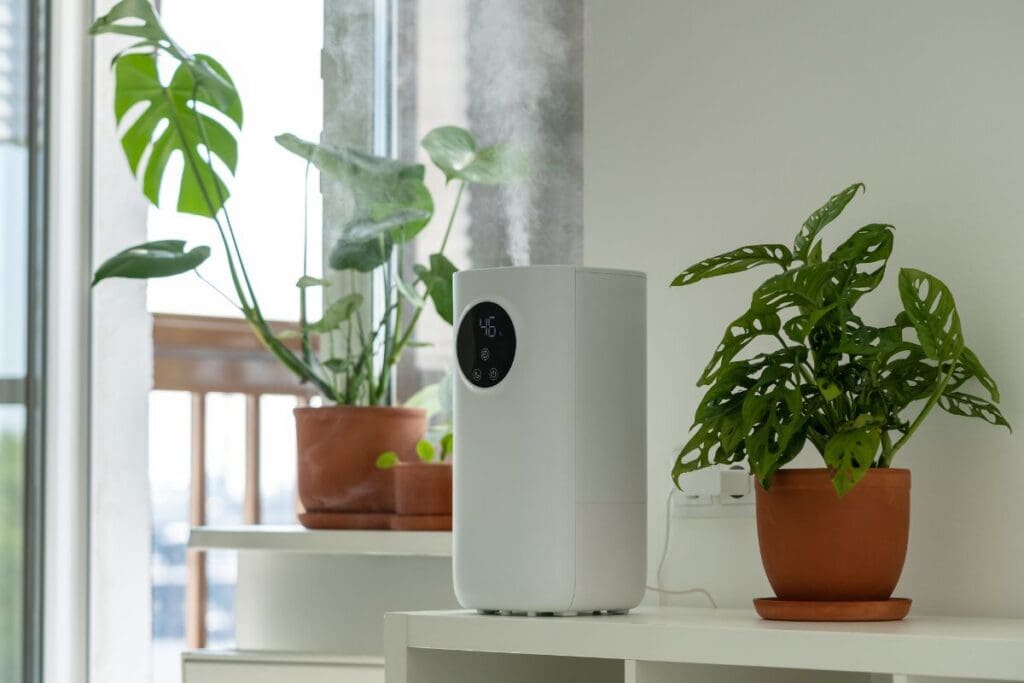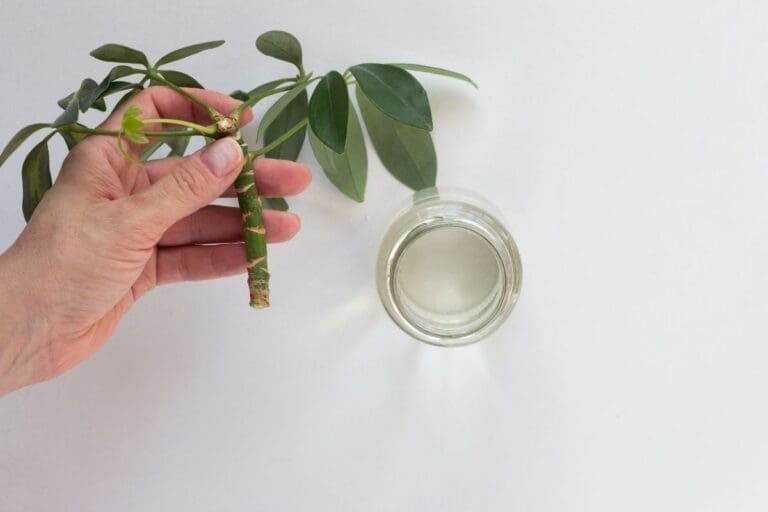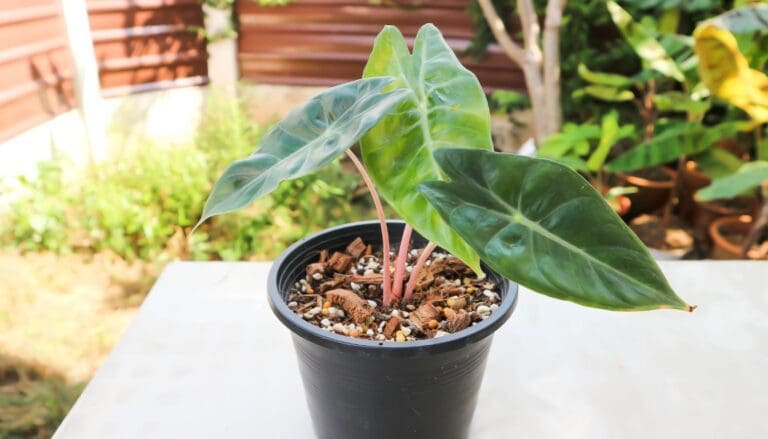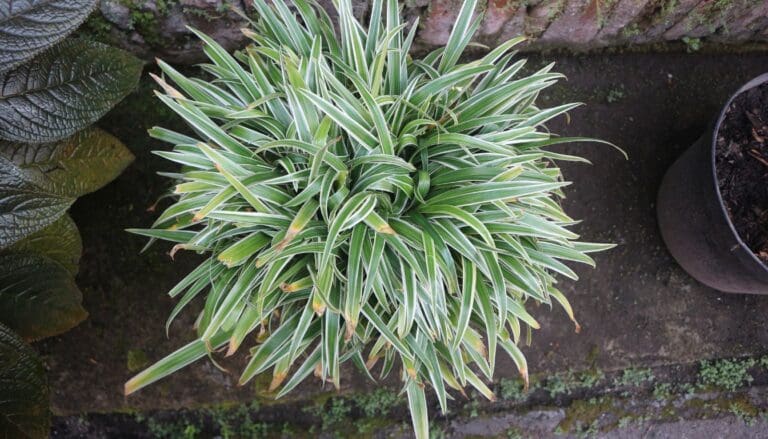Do Monstera Like To Be Misted? (Monstera Humidity Requirement+Tips)
To care for Monstera, you should provide it with all its basic requirements. Since it’s a tropical plant, it requires high humidity to develop. Misting can help in that, but will Monsteras like be misted?
Monsteras like to be misted to adjust the humidity, but the effect is temporary. Frequent misting harms the plant. Instead, use humidifiers, pebble trays, mini-greenhouses, or grouping to solve humidity issues.
In my 12 years of gardening experience, I have tested different methods to adjust the humidity for Monsteras. Stay tuned till the end to learn about misting and other alternatives to adjust humidity.

Please note: Simplify Plants is reader-supported. Some links in the post are affiliate links and I get a commission from purchases made through links in the post.
Monstera humidity preferences
Since misting is primarily done to increase the humidity levels, let’s understand the humidity preferences of Monsteras.
Monstera are native to the tropical rainforests of Central and South America. In their native land, they naturally get humidity levels between 60% and 80%.
Indoors, the environment for Monsteras is different, and hence, the humidity is lower than in their natural habitat.
High indoor humidity causes diseases due to insufficient air circulation, unlike outdoors. It also makes it uncomfortable for humans indoors.
Hence, you should create a humidity level of at least 40-60% indoors to encourage their growth.
Misting as humidity boost for Monsteras
Misting is a great way to boost the humidity levels for Monsteras.
Misting adds extra moisture to the air, keeping the humidity in check.
It’s ideal for areas where humidity levels drop occasionally.
However, you should know the basics, like the right time and frequency to mist, the right way to do it, and the pros and cons.
I get these types of questions from my readers multiple times.
Learning these basics helps you know the right way to mist and receive the benefits of it instead of facing the risks.
So, let’s understand.
When should I mist Monsteras?

Monsteras thrive in humid environments.
Misting helps create a moisture-rich atmosphere and keeps them healthy.
The right time to mist these tropical plants is during their growing season, from spring to late summer.
Since the plant’s growth is at its peak, it will need every requirement in more amounts to absorb and use them readily.
Mist at least once a week, based on the surrounding environment.
Misting in the evening will keep the leaves wet and invite pests, and misting in the mid-day will make the water droplets evaporate faster.
Hence, the right time for misting is in the early morning.
The plant will receive enough humidity, and the water droplets will have enough time throughout the day to dry out.
How often should I mist Monsteras?
The misting frequency for Monsteras depends on the environment.
In dry climates, mist Monsteras 1-2 times per week.
If you live in a moderate climate, mist the plants once per week.
You may skip misting if your living region has a warm and humid climate because it would do more harm than good.
Also, check the room temperature.
Monsteras love 65-85°F temperatures.
High temperatures don’t allow the air to hold enough moisture and lower the humidity.
You might have to mist more frequently to adjust the humidity levels.
How to mist the Monsteras correctly?
Misting does help in adjusting the humidity levels around Monsteras.
But correct misting is necessary to receive the benefits.
Choose the right mister that should be able to adjust the water pressure, mist evenly, be easy to refill, and have a comfortable grip.
While choosing a mister, assess the features and then buy the one that suits your needs.
Mist the leaves and surrounding areas of the plant evenly to add adequate moisture in the air and create ideal humidity levels.
Monitor your plant after misting to understand how it reacts to misting.
It will help you adjust the frequency and methods.
Benefits and dangers of misting Monsteras

Now that we have learned the right time, frequency, and method to mist, let’s understand some benefits and potential risks of misting Monsteras.
Pros of misting Monsteras:
- Misting helps in raising the humidity levels around the Monsteras.
- It helps remove the dust from the leaf surfaces, keep them clean, and encourage photosynthesis and chlorophyll.
- Adding some neem oil to the mist spray will prevent pest infestation and bring shine to the leaves.
- Misting also keeps the leaves hydrated and keeps them from getting too dry.
- Misting Monsteras can keep them cool in hot climates because the mist will absorb heat and keep your plant cool.
Cons of misting Monsteras:
- In less humid areas, the water from misting evaporates after 5-7 minutes. Hence, it is not an effective method to increase humidity.
- Misting in humid areas leads to the accumulation of too much moisture, which can be unhealthy for Monsteras.
- Excessive misting can damage the Monstera leaves.
- When water droplets stay on the leaves too long, it encourages pests and diseases like powdery or downy mildew, especially in highly humid areas.
- Misting can also encourage mold because wet foliage creates an ideal fungal and bacterial growth environment.
Alternative humidity solutions for Monstera
Though misting provides many benefits to Monsteras, you should consider the cons of misting.
To prevent the risks of misting, you can try other methods that are way more effective than misting and don’t harm the Monsteras.
Keep humidifiers near your Monsteras

Installing a humidifier is one of the best methods to adjust Monstera’s humidity level.
These devices create an appropriate humidity level around the Monsteras for extended periods.
These devices are handy if you have multiple tropical plants with Monsteras.
Keep them all in one room and set one humidifier.
All the plants will receive sufficient humidity as long as the device contains enough water.
Change the water regularly.
Keep Monsteras on a tray with pebbles
Take a tray filled with small pebbles or decorative stones, add water to the tray, and keep the Monstera pot over the pebbles.
As the moisture evaporates, it adds humidity to the air.
The plant’s soil will also receive some through the drainage holes.
Keep Monsteras near aquariums
Aquariums are filled with water that can evaporate and add moisture to the surrounding air.
Hence, Monsteras near aquariums will highly benefit from it.
While you can open the aquarium cover, keeping it closed is good.
With an open cover, the water evaporates faster and adds too much moisture to the air.
Open the cover only if you have kept too many tropical plants near it.
Add moss poles close to the Monsteras
Keep a moss pole near your Monsteras to adjust the humidity level around them.
Moss poles can absorb moisture and retain it for a very long time.
The water it absorbs will slowly evaporate, and the water vapor will add moisture to the surrounding air of the Monsteras.
Moss poles can also help the Monsteras to grow their aerial roots, leading to a faster growth rate.
You can get moss poles from any nearby nursery store in your locality.
Group Monstera with other tropical plants
If you have other tropical houseplants besides Monsteras, keep them close to each other.
It’s a natural and simple method to increase the humidity levels.
As the plants transpire and release moisture, they naturally add moisture to the air and increase humidity.
While keeping them in a group, keep a few things in mind:
- Please do not keep them too close to each other. Don’t let the leaves touch each other.
- Ensure good air circulation between each plant. You may run a fan or open the nearby windows.
- Choose the right plants for grouping.
Create a small indoor greenhouse for your Monstera
You can use a small greenhouse made of glass or plastic bag for the Monsteras to retain moisture.
The greenhouse box will maintain adequate humidity in the closed environment through plant transpiration, keep pests away, and encourage the Monsteras to thrive.
You can even add lights inside the greenhouse box.
With medium light levels from the artificial lights, it won’t matter if they don’t get any natural daylight.
Use a light with a timer that turns on for 10-12 hours and off for the remaining time to let the plant rest.
Keep your Monstera inside the terrariums
You can use terrarium jars as they work the same as the mini-greenhouses.
However, you must use small Monsteras because you cannot get enormous jars for tall plants.
I have seen my friend using reptile terrariums for her Monstera.
You can grow Monstera adansonii, M. Siltepecana, and M. Dubia.
Terrariums stay warm and provide good humidity to Monsteras.
You don’t even have to water the plants because when the plants transpire, the moisture evaporates and accumulates on the terrarium walls.
This water slowly falls on the soil, keeping it wet for a long time.
You can use lights in terrariums. It works the same as in the mini-greenhouses.
Reduce the temperature around your Monsteras
When the temperatures go above 85-90°F, the warm air cannot hold enough moisture, and the Monsteras suffer from low humidity.
You can slightly reduce the room temperature around your Monstera so that the air can hold the required moisture.
However, don’t go too low; that will cause dry air and cold snaps and harm the plant.
Some gardeners make the mistake of suddenly reducing the temperature around the Monsteras.
It stresses and harms the plant’s health.
So, be gradual while changing the room temperature.
Monitoring the humidity levels for Monstera

When increasing Monsteras’ humidity levels, monitor the humidity to ensure it’s correct.
You must also monitor the humidity before increasing it to ensure whether the plant needs it.
For that, use a hygrometer.
Increase the humidity when the humidity levels go below 40%.
But don’t mist the plants if the humidity is around 60%.
When humidity levels are above 60%, reduce by dehumidifiers or increasing the air circulation around the plant.
You can run a fan or open a window.
You can also keep it in an air conditioning room, provided the temperature isn’t very low and there’s a 10-12 ft. distance between.
If you don’t have a hygrometer, check out for the signs of stress.
When the air quality is dry, you ‘ll notice these signs in Monsteras:
Browning at the leaf tips and edges
- Yellowing leaves
- Wilting plant
- Slow growth
- Droopy leaves
- Curly leaves
- Dry and crispy leaves
If you notice these signs, increase the humidity.
Signs of high humidity in Monstera are:
- Discolored leaves
- Mold growth on the soil
- Fungal infections
- Excessive growth of the aerial roots
If you notice these signs, isolate and remove the infected parts of the plant, clean the mold growth, adjust watering, and reduce the humidity levels with dehumidifiers and increased airflow.
Common mistakes while misting Monstera

I get a lot of DMs and emails from my readers where they send me photos of their stressed Monsteras.
Most of the time, they are clueless about what’s wrong with their plants.
When I discuss the care tips, I learn that some of them mist their Monsteras to increase humidity.
That’s good, but they make some common mistakes.
Here are the common mistakes they make and the suggestions I have provided:
- Gardeners use tap water to mist Monsteras. If you live in a region receiving hard water, tap water will contain harmful minerals like chlorine, fluorine, or bicarbonates. These will accumulate on the leaf surface and block the leaf pores. Or, let the tap water sit overnight and evaporate the hard minerals. Then, it is good to use.
- Some people use cold or hot water for misting. Hot and cold water will shock and stress the plant. Use room temperature or tepid water for misting. You can also go for lukewarm water.
- Plant owners sometimes overmist to increase the humidity levels too much. But that doesn’t do any good. Overmisting can damage the leaves, keep the leaves wet for too long, and invite pests and fungal diseases.
- Gardeners don’t monitor their plants and the leaves after misting. Sometimes, the leaves stay wet for too long after misting, which can further invite infestations. Don’t let the leaves stay like that. Check all the leaves, and pat dry the wet leaves to avoid infestations.
- Don’t start misting without understanding the humidity levels around your Monstera. It’s unnecessary if the humidity levels are high or perfect. That will increase the level and give rise to other issues.
- Some beginners think that misting the soil might help in hydration. But that’s not the case. Misting the soil will increase the soil moisture and not the air moisture, leading to overwatering and root rot. Mist the leaves and the surroundings of the plant.
Final words
Monsteras like to be misted, which is beneficial in certain situations and environments. But, you must learn the potential risks of misting them. Misting helps in increasing the humidity levels, but temporarily. It also keeps the leaves clean and encourages good growth and development.
Mist the leaves only when the humidity levels are below 40% or when you notice signs of low humidity, like browning at the tips and edges, dry and crispy leaves, wilting, etc. Mist 1-2 times per week during the growing seasons in the early morning. Use room temperature or tepid, distilled water for misting.
For more effective methods to increase humidity, try other methods like humidifiers, pebble trays, aquariums, group planting, moss poles, mini-greenhouses, terrariums, and low temperatures. You may even shift your plant to the most humid room.
How do I know if my Monsteras need high humidity?
Look for signs like browning at the leaf tips and edges, rough and dry leaves, and leaves drooping, curling, or withering.
Is there any other way to measure the humidity?
Try using ice cubes. Keep some in a glass and leave the glass in the room where you have kept your Monstera for 5-10 minutes. Water droplets on the glass surface indicate high humidity; the opposite means low humidity.
Can I use peat moss to increase Monstera’s humidity?
Peat moss in the potting soil can increase some humidity levels for the Monsteras. Peat has the excellent ability to retain moisture, and it is eco-friendly as it’s made from decomposed plant matter.
Reference: Monstera Wikipedia
Recommended Garden Supplies
| Product Image | Our Recommended Gardening Supplies | Check Offers! |
|---|---|---|
Top Top
Top
Top
Top
Top
Top
Top
Top | rePotme Houseplant and Tropical Classic Potting Soil Mix | Check Offer On Amazon |
 Top
Top
Top
Top
Top
Top
Top
Top | Espoma Organic Indoor Plant Food | Check Offer On Amazon |
 Top
Top
Top
Top
Top
Top
Top
Top | GooingTop LED Grow Light 6000K Full Spectrum Clip Plant Growing Lamp | Check Offer On Amazon |
 Top
Top
Top
Top
Top
Top
Top
Top | Soil Moisture Meter | Check Offer On Amazon |
 Top
Top
Top
Top
Top
Top
Top
Top | Govee Hygrometer Thermometer, Bluetooth Enabled! | Check Offer On Amazon |
 Top
Top | LEVOIT Humidifiers for Large Room(Best For Plants) | Check Offer On Amazon |
 Top
Top
Top
Top
Top
Top
Top
Top | Upgraded DIY Automatic Drip Irrigation Kit, 15 Potted Houseplants Support | Check Offer On Amazon |
 Top
Top
Top
Top
Top
Top
Top
Top | Stainless Steel Heavy Duty Gardening Tool Set | Check Offer On Amazon |
 Top
Top
Top
Top
Top
Top
Top
Top | Bonide Insecticidal Soap | Check Offer On Amazon |
 Top
Top
Top
Top
Top
Top
Top
Top | Bonide 32 oz Spray Neem Oil for Organic Gardening | Check Offer On Amazon |
 Top
Top
Top
Top
Top
Top
Top
Top | Garden Safe Fungicide | Check Offer On Amazon |






